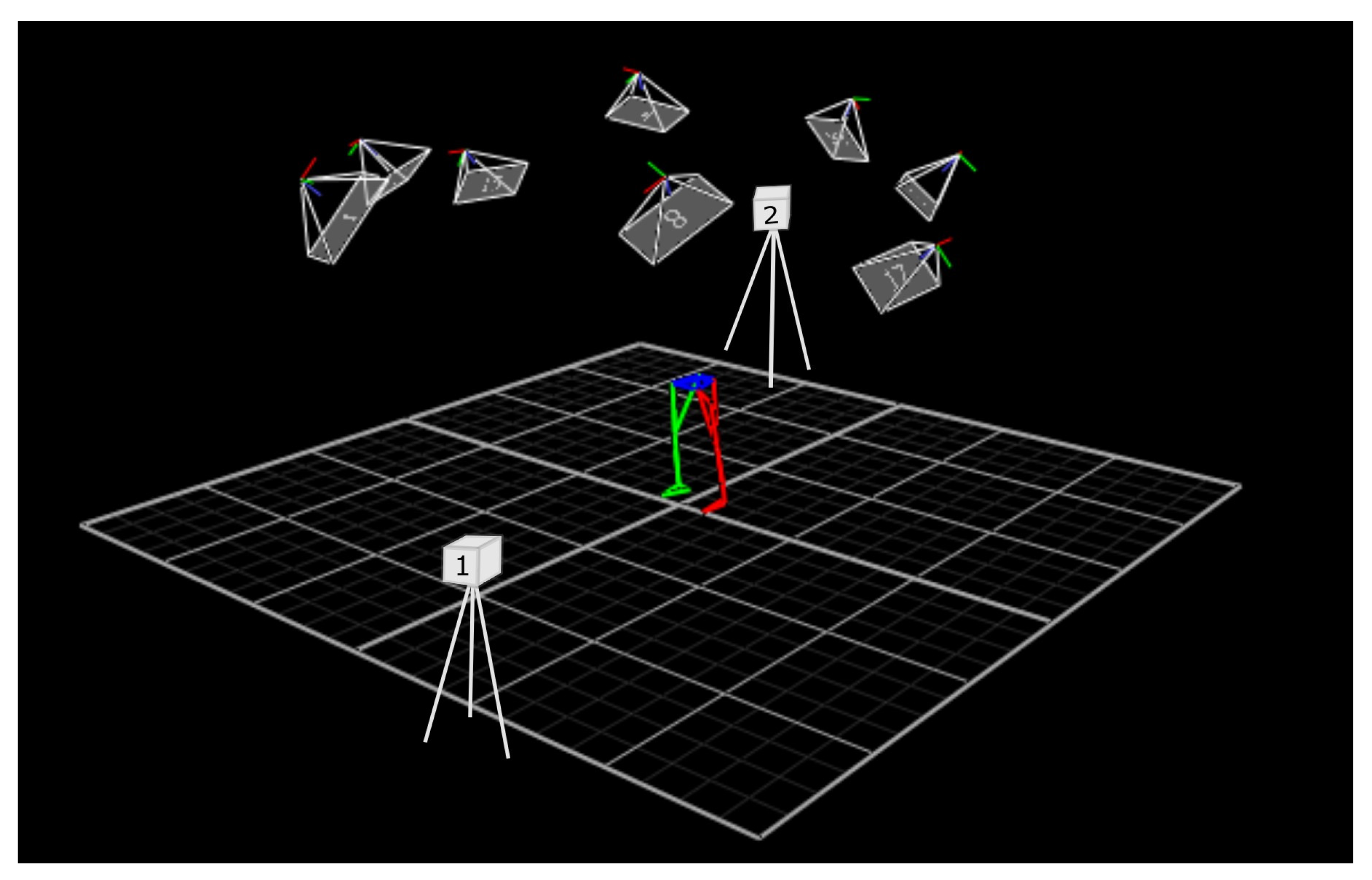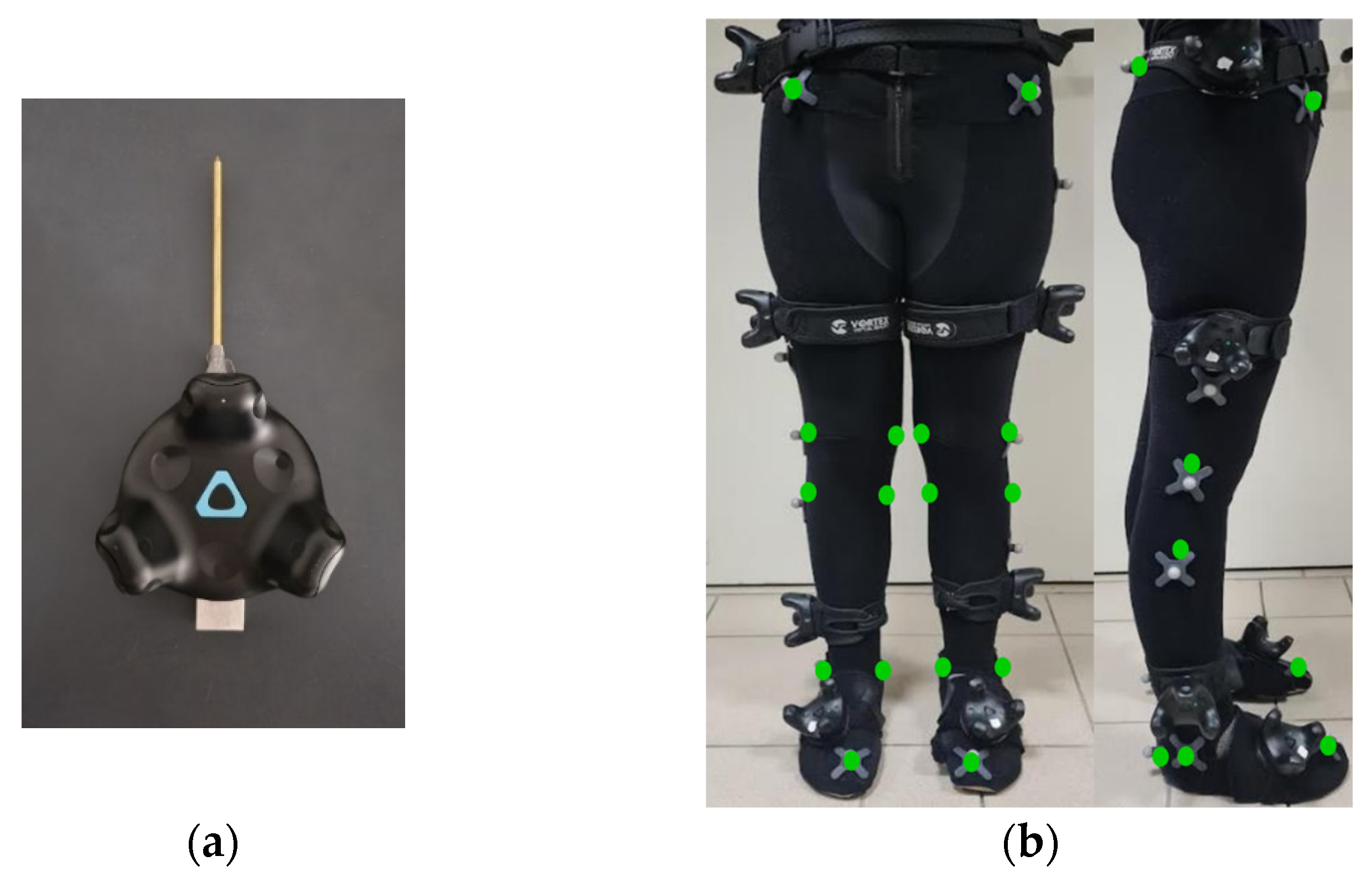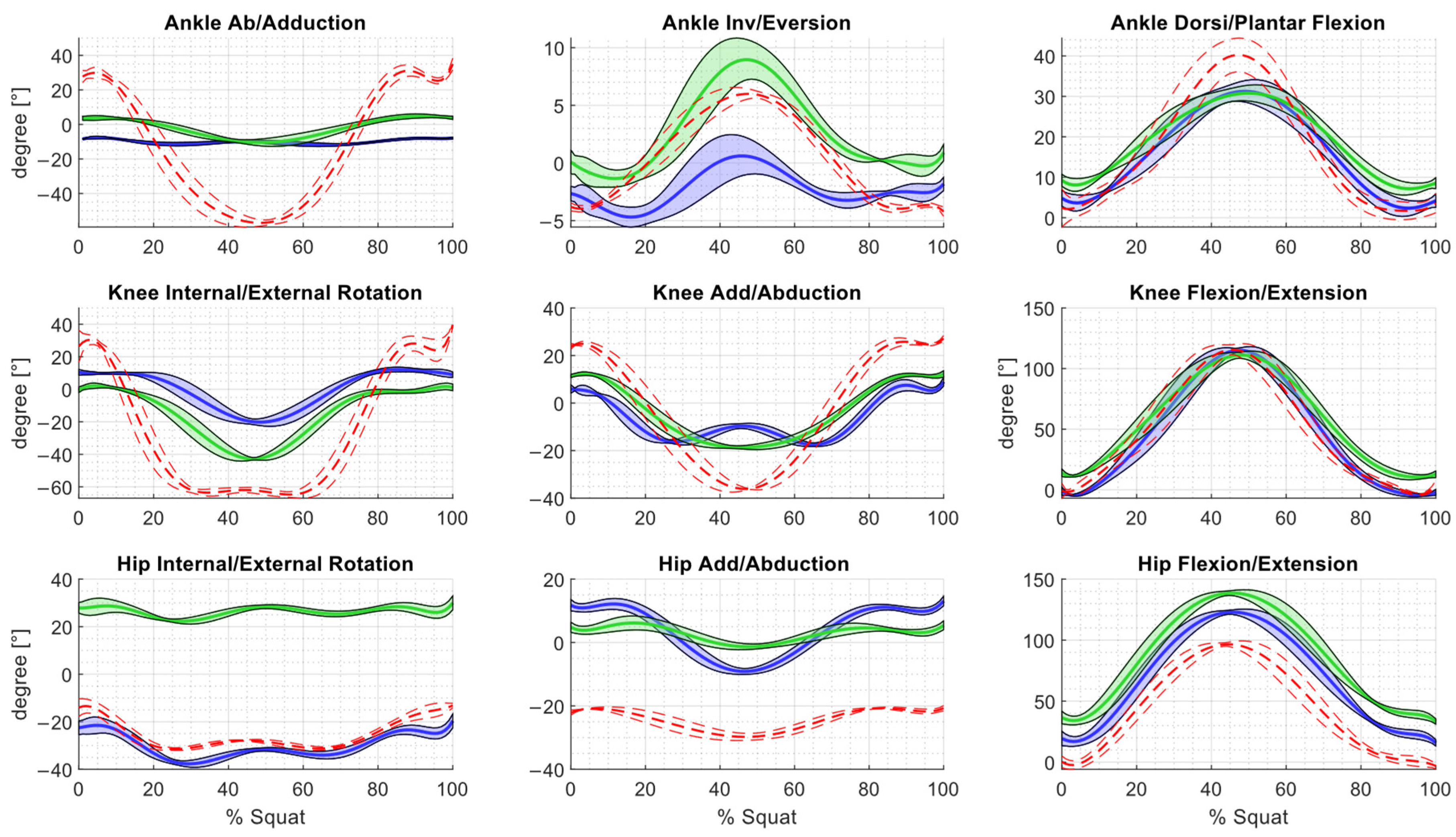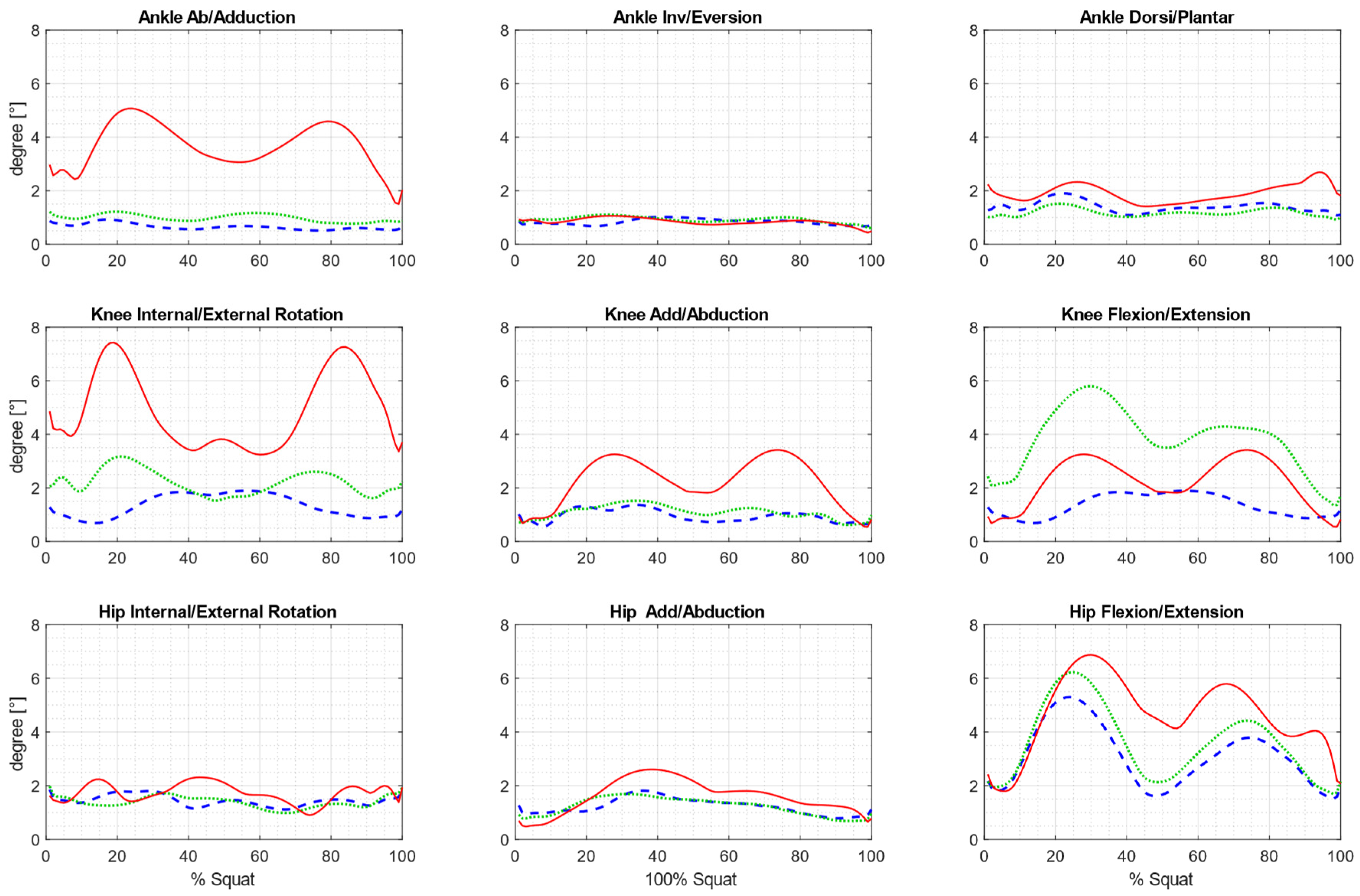Squat Kinematics Analysis Using Vicon and Affordable Motion-Capture Solutions
Abstract
1. Introduction
2. Materials and Methods
The Data Analysis
- Average joint-angle calculation (per participant):
- 2.
- Standard deviation calculation (per participant):
- 3.
- Repeat for all participants:
- 4.
- Average standard deviation across participants (per frame):
- 5.
- Overall inter-test variability (single value for the group):
3. Results
4. Discussion
5. Conclusions
Author Contributions
Funding
Institutional Review Board Statement
Informed Consent Statement
Data Availability Statement
Conflicts of Interest
References
- Hamad, A.; Jia, B. How Virtual Reality Technology Has Changed Our Lives: An Overview of the Current and Potential Applications and Limitations. Int. J. Environ. Res. Public Health 2022, 19, 11278. [Google Scholar] [CrossRef] [PubMed]
- Asadzadeh, A.; Samad-Soltani, T.; Salahzadeh, Z.; Rezaei-Hachesu, P. Effectiveness of virtual reality-based exercise therapy in rehabilitation: A scoping review. Inform. Med. Unlocked 2021, 24, 100562. [Google Scholar] [CrossRef]
- Howard, M.C.; Davis, M.M. A meta-analysis and systematic literature review of mixed reality rehabilitation programs: Investigating design characteristics of augmented reality and augmented virtuality. Comput. Hum. Behav. 2022, 130, 107197. [Google Scholar] [CrossRef]
- Matsangidou, M.; Ang, C.S.; Mauger, A.R.; Intarasirisawat, J.; Otkhmezuri, B.; Avraamides, M.N. Is your virtual self as sensational as your real? Virtual Reality: The effect of body consciousness on the experience of exercise sensations. Psychol. Sport Exerc. 2019, 41, 218–224. [Google Scholar] [CrossRef]
- Guaitolini, M.; Petros, F.E.; Prado, A.; Sabatini, A.M.; Agrawal, S.K. Evaluating the Accuracy of Virtual Reality Trackers for Computing Spatiotemporal Gait Parameters. Sensors 2021, 21, 3325. [Google Scholar] [CrossRef]
- Vox, J.P.; Weber, A.; Wolf, K.I.; Izdebski, K.; Schüler, T.; König, P.; Wallhoff, F.; Friemert, D. An Evaluation of Motion Trackers with Virtual Reality Sensor Technology in Comparison to a Marker-Based Motion Capture System Based on Joint Angles for Ergonomic Risk Assessment. Sensors 2021, 21, 3145. [Google Scholar] [CrossRef] [PubMed]
- Hofmann, S.; Özdemir, C.; Von Mammen, S. Record, Review, Edit, Apply: A Motion Data Pipeline for Virtual Reality Development & Design. In Proceedings of the 18th International Conference on the Foundations of Digital Games, Lisbon, Portugal, 12–14 April 2023; ACM: Lisbon, Portugal, 2023; pp. 1–4. [Google Scholar]
- Das, K.; De Paula Oliveira, T.; Newell, J. Comparison of markerless and marker-based motion capture systems using 95% functional limits of agreement in a linear mixed-effects modelling framework. Sci. Rep. 2023, 13, 22880. [Google Scholar] [CrossRef]
- Ota, M.; Tateuchi, H.; Hashiguchi, T.; Kato, T.; Ogino, Y.; Yamagata, M.; Ichihashi, N. Verification of reliability and validity of motion analysis systems during bilateral squat using human pose tracking algorithm. Gait Posture 2020, 80, 62–67. [Google Scholar] [CrossRef]
- Czajkowska, U.; Żuk, M.; Pezowicz, C.; Popek, M.; Łopusiewicz, M.; Bulińska, K. Low-Cost Motion Tracking Systems in the Kinematics Analysis of VR Game Users—Preliminary Study. In Innovations in Biomedical Engineering 2024; Gzik, M., Paszenda, Z., Piętka, E., Milewski, K., Jurkojć, J., Eds.; Lecture Notes in Networks and Systems; Springer Nature: Cham, Switzerland, 2025; Volume 1202, pp. 15–28. ISBN 978-3-031-82142-4. [Google Scholar]
- Yin, W.; Reddy, C.; Zhou, Y.; Zhang, X. A Novel Application of Flexible Inertial Sensors for Ambulatory Measurement of Gait Kinematics. IEEE Trans. Human-Mach. Syst. 2021, 51, 346–354. [Google Scholar] [CrossRef]
- García-de-Villa, S.; Casillas-Pérez, D.; Jiménez-Martín, A.; García-Domínguez, J.J. Inertial Sensors for Human Motion Analysis: A Comprehensive Review. IEEE Trans. Instrum. Meas. 2023, 72, 4006439. [Google Scholar] [CrossRef]
- Niswander, W.; Wang, W.; Kontson, K. Optimization of IMU Sensor Placement for the Measurement of Lower Limb Joint Kinematics. Sensors 2020, 20, 5993. [Google Scholar] [CrossRef] [PubMed]
- Wittmann, F.; Lambercy, O.; Gassert, R. Magnetometer-Based Drift Correction During Rest inIMU Arm Motion Tracking. Sensors 2019, 19, 1312. [Google Scholar] [CrossRef] [PubMed]
- Faity, G.; Mottet, D.; Froger, J. Validity and Reliability of Kinect v2 for Quantifying Upper Body Kinematics during Seated Reaching. Sensors 2022, 22, 2735. [Google Scholar] [CrossRef] [PubMed]
- Horsak, B.; Prock, K.; Krondorfer, P.; Siragy, T.; Simonlehner, M.; Dumphart, B. Inter-trial variability is higher in 3D markerless compared to marker-based motion capture: Implications for data post-processing and analysis. J. Biomech. 2024, 166, 112049. [Google Scholar] [CrossRef]
- Puig-Diví, A.; Escalona-Marfil, C.; Padullés-Riu, J.M.; Busquets, A.; Padullés-Chando, X.; Marcos-Ruiz, D. Validity and reliability of the Kinovea program in obtaining angles and distances using coordinates in 4 perspectives. PLoS ONE 2019, 14, e0216448. [Google Scholar] [CrossRef]
- Fernández-González, P.; Koutsou, A.; Cuesta-Gómez, A.; Carratalá-Tejada, M.; Miangolarra-Page, J.C.; Molina-Rueda, F. Reliability of Kinovea® Software and Agreement with a Three-Dimensional Motion System for Gait Analysis in Healthy Subjects. Sensors 2020, 20, 3154. [Google Scholar] [CrossRef]
- Lun, R.; Zhao, W. A Survey of Applications and Human Motion Recognition with Microsoft Kinect. Int. J. Patt. Recogn. Artif. Intell. 2015, 29, 1555008. [Google Scholar] [CrossRef]
- Maria Coruzzolo, A.; Forgione, C.; Di Natali, C.; Lolli, F. Ergonomic risk reduction in picking activities: Evaluation of an active exoskeleton through Azure Kinect. Phys. Ergon. Hum. Factors 2024, 147. [Google Scholar] [CrossRef]
- Guffanti, D.; Brunete, A.; Hernando, M.; Álvarez, D.; Gambao, E.; Chamorro, W.; Fernández-Vázquez, D.; Navarro-López, V.; Carratalá-Tejada, M.; Miangolarra-Page, J.C. Robotics-driven gait analysis: Assessing Azure Kinect’s performance in in-lab versus in-corridor environments. J. Field Robot. 2024, 41, 1133–1145. [Google Scholar] [CrossRef]
- Ramasubramanian, A.K.; Kazasidis, M.; Fay, B.; Papakostas, N. On the Evaluation of Diverse Vision Systems towards Detecting Human Pose in Collaborative Robot Applications. Sensors 2024, 24, 578. [Google Scholar] [CrossRef]
- Bauer, P.; Lienhart, W.; Jost, S. Accuracy Investigation of the Pose Determination of a VR System. Sensors 2021, 21, 1622. [Google Scholar] [CrossRef] [PubMed]
- Spitzley, K.A.; Karduna, A.R. Feasibility of using a fully immersive virtual reality system for kinematic data collection. J. Biomech. 2019, 87, 172–176. [Google Scholar] [CrossRef] [PubMed]
- Żuk, M.; Wojtków, M.; Popek, M.; Mazur, J.; Bulińska, K. Three-dimensional gait analysis using a virtual reality tracking system. Measurement 2022, 188, 110627. [Google Scholar] [CrossRef]
- Merker, S.; Pastel, S.; Bürger, D.; Schwadtke, A.; Witte, K. Measurement Accuracy of the HTC VIVE Tracker 3.0 Compared to Vicon System for Generating Valid Positional Feedback in Virtual Reality. Sensors 2023, 23, 7371. [Google Scholar] [CrossRef]
- Kadaba, M.P.; Ramakrishnan, H.K.; Wootten, M.E. Measurement of lower extremity kinematics during level walking. J. Orthop. Res. 1990, 8, 383–392. [Google Scholar] [CrossRef]
- Armand, S.; Sawacha, Z.; Goudriaan, M.; Horsak, B.; Van Der Krogt, M.; Huenaerts, C.; Daly, C.; Kranzl, A.; Boehm, H.; Petrarca, M.; et al. Current practices in clinical gait analysis in Europe: A comprehensive survey-based study from the European society for movement analysis in adults and children (ESMAC) standard initiative. Gait Posture 2024, 111, 65–74. [Google Scholar] [CrossRef]
- Bell, A.L.; Brand, R.A.; Pedersen, D.R. Prediction of hip joint centre location from external landmarks. Hum. Mov. Sci. 1989, 8, 3–16. Available online: https://linkinghub.elsevier.com/retrieve/pii/0167945789900201 (accessed on 21 May 2025). [CrossRef]
- Żuk, M.; Pezowicz, C. Kinematic Analysis of a Six-Degrees-of-Freedom Model Based on ISB Recommendation: A Repeatability Analysis and Comparison with Conventional Gait Model. Appl. Bionics Biomech. 2015, 2015, 503713. [Google Scholar] [CrossRef] [PubMed]
- Chan, C.-K.; Azah, H.N.; Yeow, C.-H.; Goh, S.-K.; Ting, H.-N.; Salmah, K. Effects of squatting speed and depth on lower extremity kinematics, kinetics and energetics. J. Mech. Med. Biol. 2022, 22, 2250032. [Google Scholar] [CrossRef]
- Schwartz, M.H.; Trost, J.P.; Wervey, R.A. Measurement and management of errors in quantitative gait data. Gait Posture 2004, 20, 196–203. [Google Scholar] [CrossRef]
- Manca, M.; Leardini, A.; Cavazza, S.; Ferraresi, G.; Marchi, P.; Zanaga, E.; Benedetti, M.G. Repeatability of a new protocol for gait analysis in adult subjects. Gait Posture 2010, 32, 282–284. [Google Scholar] [CrossRef] [PubMed]
- Chiari, L.; Croce, U.D.; Leardini, A.; Cappozzo, A. Human movement analysis using stereophotogrammetry: Part 2: Instrumental errors. Gait Posture 2005, 21, 197–211. [Google Scholar] [CrossRef] [PubMed]
- Ji, R.; Lee, W.Y.; Guan, X.; Yan, B.; Yang, L.; Yang, J.; Wang, L.; Tao, C.; Kuai, S.; Fan, Y. Comparison of plugin and redundant marker sets to analyze gait kinematics between different populations. BioMed. Eng OnLine 2023, 22, 122. [Google Scholar] [CrossRef]
- Paterson, K.L.; Hinman, R.S.; Metcalf, B.R.; Bennell, K.L.; Wrigley, T.V. Plug-in-Gait calculation of the knee adduction moment in people with knee osteoarthritis during shod walking: Comparison of two different foot marker models. J. Foot Ankle Res. 2017, 10, 8. [Google Scholar] [CrossRef]
- Rosso, V.; Agostini, V.; Takeda, R.; Tadano, S.; Gastaldi, L. Influence of BMI on Gait Characteristics of Young Adults: 3D Evaluation Using Inertial Sensors. Sensors 2019, 19, 4221. [Google Scholar] [CrossRef]
- Hora, M.; Soumar, L.; Pontzer, H.; Sládek, V. Body size and lower limb posture during walking in humans. PLoS ONE 2017, 12, e0172112. [Google Scholar] [CrossRef]
- Rekant, J.; Rothenberger, S.; Chambers, A. Obesity-Specific Considerations for Assessing Gait with Inertial Measurement Unit-Based vs. Optokinetic Motion Capture. Sensors 2024, 24, 1232. [Google Scholar] [CrossRef]
- Kristiansen, M.; Rasmussen, G.H.F.; Sloth, M.E.; Voigt, M. Inter- and intra-individual variability in the kinematics of the back squat. Hum. Mov. Sci. 2019, 67, 102510. [Google Scholar] [CrossRef] [PubMed]
- Erman, B.; Vural, F.; Dopsaj, M.; Ozkol, M.Z.; Kose, D.E.; Aksit, T. The effects of fatigue on linear and angular kinematics during bilateral squat. PLoS ONE 2023, 18, e0289089. [Google Scholar] [CrossRef]
- Tuyà Viñas, S.; Fernández-Valdés Villa, B.; Pérez-Chirinos Buxadé, C.; Morral-Yepes, M.; Del Campo Montoliu, L.; Moras Feliu, G. Adding mechanical vibration to a half squat with different ballasts and rhythms increases movement variability. PLoS ONE 2023, 18, e0284863. [Google Scholar] [CrossRef]
- Cowin, J.; Nimphius, S.; Fell, J.; Culhane, P.; Schmidt, M. A Proposed Framework to Describe Movement Variability within Sporting Tasks: A Scoping Review. Sports Med-Open 2022, 8, 85. [Google Scholar] [CrossRef] [PubMed]
- Morral Yepes, M.; Gonzalo-Skok, O.; Fernández Valdés, B.; Bishop, C.; Tuyà, S.; Moras Feliu, G. Assessment of movement variability and time in a football reactive agility task depending on constraints. Sports Biomech. 2023, 22, 1–17. [Google Scholar] [CrossRef]
- Pereira, M.J.; Dias, G.; Mendes, R.; Martins, F.; Gomes, R.; Castro, M.A.; Vaz, V. Movement variability in Pilates: A scoping review. Front. Psychol. 2023, 14, 1195055. [Google Scholar] [CrossRef] [PubMed]
- Fernandes, O. Methods for Analyzing Movement Variability. In Graphonomics in Human Body Movement. Bridging Research and Practice from Motor Control to Handwriting Analysis and Recognition; Parziale, A., Diaz, M., Melo, F., Eds.; Lecture Notes in Computer Science; Springer Nature: Cham, Switzerland, 2023; Volume 14285, pp. 191–202. ISBN 978-3-031-45460-8. [Google Scholar]
- Kanko, R.M.; Laende, E.; Selbie, W.S.; Deluzio, K.J. Inter-session repeatability of markerless motion capture gait kinematics. J. Biomech. 2021, 121, 110422. [Google Scholar] [CrossRef]
- Kaufman, K.; Miller, E.; Kingsbury, T.; Russell Esposito, E.; Wolf, E.; Wilken, J.; Wyatt, M. Reliability of 3D gait data across multiple laboratories. Gait Posture 2016, 49, 375–381. [Google Scholar] [CrossRef]
- Everaert, L.; Dewit, T.; Huenaerts, C.; Staut, L.; Adams, H.; Labey, L.; Van Campenhout, A.; Desloovere, K. Variability of gait analysis in children with Cerebral Palsy across different conditions. Gait Posture 2023, 106, S57–S58. [Google Scholar] [CrossRef]
- Michelini, A.; Eshraghi, A.; Andrysek, J. Two-dimensional video gait analysis: A systematic review of reliability, validity, and best practice considerations. Prosthet. Orthot. Int. 2020, 44, 245–262. [Google Scholar] [CrossRef]
- Vitali, R.V.; Perkins, N.C. Determining anatomical frames via inertial motion capture: A survey of methods. J. Biomech. 2020, 106, 109832. [Google Scholar] [CrossRef]
- Kanko, R.M.; Outerleys, J.B.; Laende, E.K.; Selbie, W.S.; Deluzio, K.J. Comparison of Concurrent and Asynchronous Running Kinematics and Kinetics From Marker-Based and Markerless Motion Capture Under Varying Clothing Conditions. J. Appl. Biomech. 2024, 40, 129–137. [Google Scholar] [CrossRef]
- McFadden, C.; Daniels, K.; Strike, S. The sensitivity of joint kinematics and kinetics to marker placement during a change of direction task. J. Biomech. 2020, 101, 109635. [Google Scholar] [CrossRef]
- Ferrari, A.; Benedetti, M.G.; Pavan, E.; Frigo, C.; Bettinelli, D.; Rabuffetti, M.; Crenna, P.; Leardini, A. Quantitative comparison of five current protocols in gait analysis. Gait Posture 2008, 28, 207–216. [Google Scholar] [CrossRef] [PubMed]
- Flux, E.; Van Der Krogt, M.M.; Cappa, P.; Petrarca, M.; Desloovere, K.; Harlaar, J. The Human Body Model versus conventional gait models for kinematic gait analysis in children with cerebral palsy. Hum. Mov. Sci. 2020, 70, 102585. [Google Scholar] [CrossRef] [PubMed]
- Brockett, C.L.; Chapman, G.J. Biomechanics of the ankle. Orthop. Trauma 2016, 30, 232–238. [Google Scholar] [CrossRef] [PubMed]
- Ancillao, A.; Verduyn, A.; Vochten, M.; Aertbeliën, E.; De Schutter, J. A Novel Procedure for Knee Flexion Angle Estimation Based on Functionally Defined Coordinate Systems and Independent of the Marker Landmarks. Int. J. Environ. Res. Public Health 2022, 20, 500. [Google Scholar] [CrossRef]
- Della Croce, U.; Leardini, A.; Chiari, L.; Cappozzo, A. Human movement analysis using stereophotogrammetry: Part 4: Assessment of anatomical landmark misplacement and its effects on joint kinematics. Gait Posture 2005, 21, 226–237. [Google Scholar] [CrossRef]






| Rotations | eMotion + Simplified 6DOF with Trackers | eMotion + ISB 6DOF with Trackers | Vicon + Plug-In Gait Model |
|---|---|---|---|
| Hip flex/ext | 78.9° +/− 24.6° | 96.1° +/− 24.6° | 87.8° +/− 10.9° |
| Hip abd/add | 22.3° +/− 6.8° | 21.0° +/− 11.2° | 19.2° +/− 9.6° |
| Hip int/ext | 24.2° +/− 8.3° | 24.2° +/− 18.1° | 19.9° +/− 4.1° |
| Knee flex/ext | 110.3° +/− 17.2° | 104.9° +/− 34.8° | 100.8° +/−15.1° |
| Knee abd/add | 18.5° +/− 7.3° | 26.4° +/− 23.8° | 45.1° +/− 10.2° |
| Knee int/ext rotation | 19.0° +/− 12.0° | 54.9° +/− 44.4° | 90.7° +/− 18.9° |
| Ankle dor/pla | 28.7° +/− 5.5° | 20.4° +/− 11.1° | 33.1° +/− 7.2° |
| Ankle inv/ev | 6.25° +/− 3.2° | 12.3° +/− 5.2° | 14.0° +/− 10.5° |
| Ankle abd/add | 4.9° +/− 2.1° | 14.0° +/− 6.8° | 65.3° +/− 21.9° |
| Rotations | eMotion + ISB 6DOF with Trackers Compared with eMotion + Simplified 6DOF with Trackers | eMotion + ISB 6DOF with Trackers Compared with Vicon + Plug-In Gait Model | eMotion + Simplified 6DOF with Trackers Compared with Vicon + Plug-in Gait Model |
|---|---|---|---|
| Hip flex/ext | 16.7° +/− 24.1° | 9.0° +/− 8.5° | 8.1° +/− 21.6° |
| Hip abd/add | 0.8° +/− 15.6° | 3.1° +/− 9.1° | 2.4° +/− 17.6° |
| Hip int/ext | 0.5° +/− 20.2° | 4.4° +/− 21.3° | 5.1° +/− 19.5° |
| Knee flex/ext | 5.8° +/− 27.5° | 8.2° +/− 18.2° | 2.5° +/− 33.4° |
| Knee abd/add | 9.0° +/− 22.1° | 27.5° +/− 8.1° | 18.6° +/− 26.5° |
| Knee int/ext rotation | 38.1° +/− 49.3° | 70.7° +/− 21.5° | 35.4° +/− 39.6° |
| Ankle dor/pla | 8.4° +/− 7.0° | 5.4° +/− 7.0° | 13.7° +/− 9.1° |
| Ankle inv/ev | 5.7° +/− 6.0° | 6.6° +/− 13.3° | 0.7° +/− 12.0° |
| Ankle abd/add | 9.3° +/− 6.2° | 60.3° +/− 22.5° | 50.9° +/− 26.5° |
| Rotations [◦] | Present Study | Previous Study | ||||
|---|---|---|---|---|---|---|
| eMotion + Simplified 6DOF with Trackers | eMotion + ISB 6DOF with Trackers | Vicon + Plug-In Gait Model | Simplified 6DOF with Trackers [25] | ISB 6DOF with Trackers [25] | Modified Helen Hayes Marker Set [32] | |
| Hip flex/ext | 3.09 | 3.58 | 1.73 | 1.56 | 1.36 | 1.2 |
| Hip abd/add | 1.23 | 1.22 | 1.60 | 0.91 | 0.89 | 0.5 |
| Hip int/ext | 1.45 | 1.39 | 4.63 | 1.63 | 1.44 | 1.2 |
| Knee flex/ext | 4.01 | 3.83 | 4.91 | 2.25 | 2.18 | 1.6 |
| Knee abd/add | 0.95 | 1.09 | 2.22 | 0.69 | 0.75 | 0.5 |
| Knee int/ext rotation | 1.34 | 2.20 | 4.75 | 1.32 | 1.37 | 1.2 |
| Ankle dor/pla | 1.39 | 1.18 | 3.66 | 1.62 | 1.59 | 1.3 |
| Ankle inv/ev | 0.83 | 0.92 | 0.84 | 1.26 | 1.22 | - |
| Ankle abd/add | 0.65 | 0.99 | 1.91 | 1.36 | 1.44 | 1.7 |
| Rotations | eMotion + ISB 6DOF with Trackers Compared with eMotion + Simplified 6DOF with Trackers | eMotion + ISB 6DOF with Trackers Compared with Vicon + Plug-In Gait Model | eMotion + Simplified 6DOF with Trackers Compared with Vicon + Plug-In Gait Model |
|---|---|---|---|
| Hip flex/ext | p = 0.087 | p < 0.001 | p < 0.001 |
| Hip abd/add | p = 0.248 | p < 0.001 | p < 0.001 |
| Hip int/ext | p = 0.374 | p < 0.001 | p < 0.001 |
| Knee flex/ext | p = 0.117 | p = 0.083 | p = 0.865 |
| Knee abd/add | p = 0.437 | p < 0.001 | p < 0.001 |
| Knee int/ext rotation | p = 0.437 | p < 0.001 | p < 0.001 |
| Ankle dor/pla | p < 0.001 | p < 0.001 | p < 0.001 |
| Ankle inv/ev | p = 0.905 | p = 0.08 | p = 0.061 |
| Ankle abd/add | p < 0.05 | p < 0.001 | p < 0.001 |
Disclaimer/Publisher’s Note: The statements, opinions and data contained in all publications are solely those of the individual author(s) and contributor(s) and not of MDPI and/or the editor(s). MDPI and/or the editor(s) disclaim responsibility for any injury to people or property resulting from any ideas, methods, instructions or products referred to in the content. |
© 2025 by the authors. Licensee MDPI, Basel, Switzerland. This article is an open access article distributed under the terms and conditions of the Creative Commons Attribution (CC BY) license (https://creativecommons.org/licenses/by/4.0/).
Share and Cite
Czajkowska, U.; Popek, M.; Pezowicz, C.; Leśnik, B.; Żuk, M. Squat Kinematics Analysis Using Vicon and Affordable Motion-Capture Solutions. Sensors 2025, 25, 3294. https://doi.org/10.3390/s25113294
Czajkowska U, Popek M, Pezowicz C, Leśnik B, Żuk M. Squat Kinematics Analysis Using Vicon and Affordable Motion-Capture Solutions. Sensors. 2025; 25(11):3294. https://doi.org/10.3390/s25113294
Chicago/Turabian StyleCzajkowska, Urszula, Michał Popek, Celina Pezowicz, Bogna Leśnik, and Magdalena Żuk. 2025. "Squat Kinematics Analysis Using Vicon and Affordable Motion-Capture Solutions" Sensors 25, no. 11: 3294. https://doi.org/10.3390/s25113294
APA StyleCzajkowska, U., Popek, M., Pezowicz, C., Leśnik, B., & Żuk, M. (2025). Squat Kinematics Analysis Using Vicon and Affordable Motion-Capture Solutions. Sensors, 25(11), 3294. https://doi.org/10.3390/s25113294





